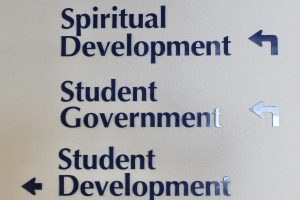Plans for the Multicultural Student Center (MSC) have been delayed due to estimated costs being higher than initially projected. The multicultural center will be used for members of the MOSAIC club.
“The project was approved in concept, pending research on other aspects of the space itself,” said Caye Smith, the vice president for Student Development. “So the project conceptually was approved — the idea is approved. There is 100 percent support for identifying and developing space. The timeline has been extended, but it has not been denied.”
The MOSAIC organization is made up of eight different clubs, including the Asian Student Union (ASU), Association of Latin American Students (ALAS) and Black Student Union (BSU).The proposal for the center, led by Chief Diversity Officer Jeffrey Carr, has been in process for a few years.
“I took the leadership on creating the proposal, which included reviewing many options on campus based on who was in the current space, what current space can become vacant or reconfiguring space,” Carr said.
Physical Plant was asked to provide the first estimated cost of the project, or draft bid, and gave it to Carr last summer. The calculation was about $15,000 for the finished work and $15,000 for the construction of the building, adding up to $30,000-$35,000, according to Carr.
Because the Physical Plant’s employees are often involved in various campus projects, the cabinet asked Physical Plant to seek an estimate from a construction company outside of PLNU. When the Administrative Cabinet received that final bid, it was around $55,000, a sum much larger than that in the proposal.
“In the whole scheme of things, that’s actually not a lot of money,” said Carr. “It’s just that it was different.”
ASB offered $10,000 toward the Student Senate-approved project, and members of MOSAIC have volunteered to fundraise in assistance to the cost, but the space for the center has not yet been established.
Carr’s proposal originally suggested the center be built in the entryway of the ARC, but other options are currently being explored.
“We’re looking broadly at space, we’re looking at the utilization of space, and we’re looking for an appropriate place for the multicultural student center,” said Smith. “Appropriate on good, central, visible space that can also affordably be renovated or remodeled to meet the needs of a multicultural student center.”
The idea for the center is to make the student body more aware of the multicultural clubs on campus.
“I feel like the center is a big step for minorities to feel like they are being assessed,” said Meaghan Zuttermeister, president of the Hui O’ Hawaii’. “Throughout the day, we could have like a study lounge, where clubs could plan things…kind of like a student center for clubs.”
Currently, multicultural clubs meet in the commuter lounge in Nicholson Commons.
Carr said the creation of a visible space dedicated to the needs of students within PLNU’s multicultural organization is important for each of the diversity clubs.
“They do all of this with virtually no support, and I think the university rightly realizes they need to provide support that would help them both be more successful and to gain more from the kinds of interactions that these affinity organizations present to students,” said Carr. “I think that’s an expectation in their higher education liberal arts student experience.”
On Thursday, Smith sent a letter to the student presidents of the eight multicultural clubs on campus, explaining the search for an appropriate space will continue throughout the Spring 2014 semester in the of hope identifying a location by its end. It will not likely be developed during that time. While the cabinet affirms the importance of this project, they are working and inquiring about other campus projects involving spatial issues as well.
“[T]here can be three perceptions of every situation,” said Carr. “So I’m sure administration has one perception, one set of priorities, one set of things that they look at. Students have their perceptions, priorities that they look at. Then there’s the area where those two things kind of cross over that lies the reality of where things usually end up.”






